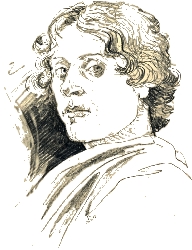  Sandro Botticelli (born 1445, died 1510) was an Italian painter and one of the greatest painters of the Florentine Renaissance. His The Birth of Venus and La Primavera are often said to epitomize the spirit of the Renaissance.
Sandro Botticelli (born 1445, died 1510) was an Italian painter and one of the greatest painters of the Florentine Renaissance. His The Birth of Venus and La Primavera are often said to epitomize the spirit of the Renaissance. It’s possible that Western art history wouldn’t have been the same without Botticelli. With members of the influential Medici family as his patrons, Botticelli received many commissions, some of which are considered the Renaissance movement’s best achievements. Throughout the latter half of the 15th century, he produced portraits of the city of Florence's elite, as well as religious and mythological scenes that began a new era of artistic achievement. Botticelli’s preference for painting would lead him to the first part of his artistic career as a teenager, when in the late 1450s he entered the studio of the artist Fra Filippo Lippi, whose pale hues would influence Botticelli’s later works. Botticelli also studied with other leading Renaissance painters like Antonio Pollaiuolo and Andrea del Verrochio, whose sculptures emphasized human anatomy in a way that would later appear in Botticelli’s own art. Botticelli worked in all the genres of Florentine art. He painted altarpieces on panels, round paintings, small panel pictures, and small devotional triptychs (paintings made up of three sections). He painted in fresco, a form of mural painting in which earth pigments are painted directly on fresh, wet, lime plaster. As the plaster dries, a chemical process bonds the pigment and plaster together. Leonardo da Vinci used this method. It was the Italian Medici family that would help to solidify Botticelli’s reputation. His rise to fame was helped by the reign of Lorenzo the Magnificent, who cultivated an elite circle of scholars, art patrons, and bankers. The family would help finance one of Botticelli’s earliest masterworks, Adoration of the Magi (1475–76), which was commissioned for the altar at the church of Santa Maria Novella. Featuring a frontal view of the religious scene, the painting includes portraits of the three Wise Men, whose faces were based on the visages of Medici family members! Also included is a portrait of the artist on the far right facing the viewer. By 1480, Botticelli had reached the height of his career. In 1481, Botticelli was among several Italian painters, in addition to Michaelangelo, hired to decorate the Sistine Chapel. Positioned opposite the Pope's throne, Botticelli’s painting Temptations of Christ portrays Christ’s various triumphs over a disguised Satan, as described in the Book of Matthew. During the 1480s and ’90s, as Renaissance artists were growing in prominence, Botticelli produced two of his most famous works: La Primavera and the Birth of Venus. Both feature mythological subjects, popular in Italy at the time. Imitating ancient Greek artists, The Birth of Venus features a central female figure modeled on the famous 'Venus pudica' pose. ['Venus pudica' is a term used to describe a classic pose in Western art where an unclothed female (either standing or reclining) keeps one hand covering her private parts. The resultant pose is somewhat asymmetrical and often serves to draw one's eye to the very spot being hidden!] Many of Botticelli’s figures have naturalistic-looking bodies that were anatomically correct, but here, the artist chose to slightly elongate Venus’s chest for artistic purposes. Much of Botticelli's secular (non-religious) work is lost; from his career of some 40 years, only eight examples by him survive, all single-figure portraits. Among the most famous is Young Man Holding a Medal. Botticelli’s late-career period focused on devotional subjects. For example, he created The Mystical Nativity, merging both the story of Christ’s birth and His return at the end of the world into one canvas. The painting is said to mark a return by Botticelli to medieval painting conventions. Botticelli died in 1510. From then on, his work went relatively unnoticed until renewed interest came in the 19th century.
|